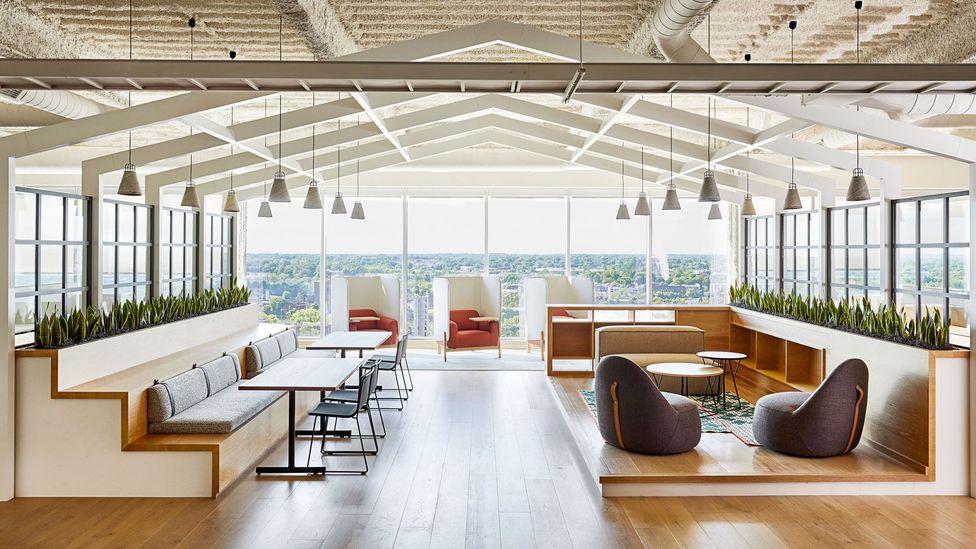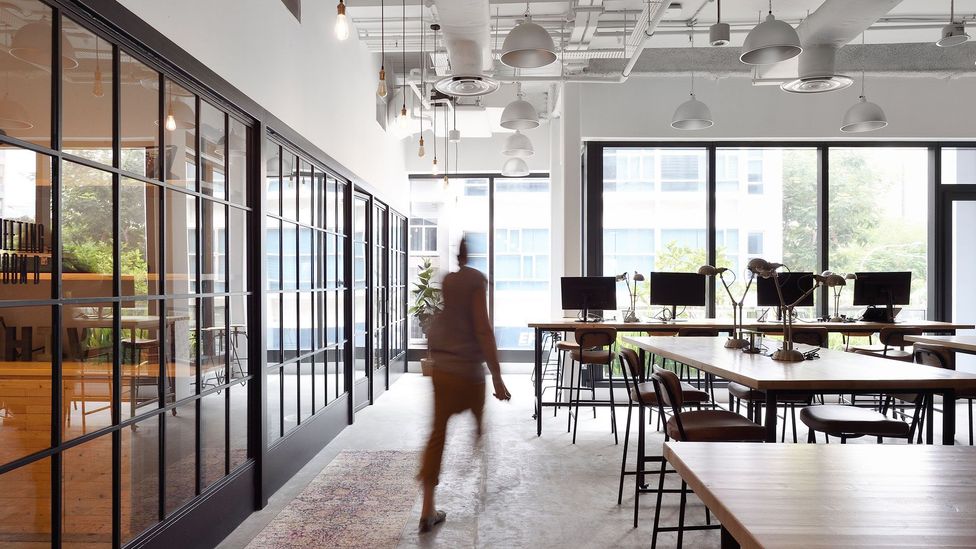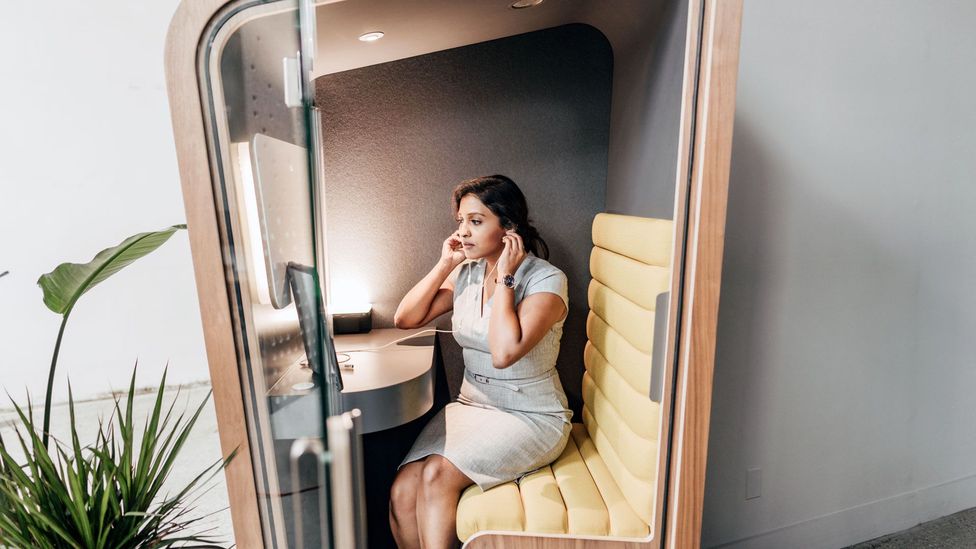The employees of LendingTree, an online loan marketplace headquartered in Charlotte, North Carolina, US, are still working from desks and couches, on patios and in libraries. But rather than doing so remotely, they’re in a corporate office that’s been re-designed to include environments that mimic working from home. LendingTree calls the concept “resi-mercial”.
“It’s a blend of a residential and commercial feel,” says Jill Olmstead, LendingTree’s chief human resources and administration officer. “The idea is that it’s comfortable, and you want to be here as much as you want to be at home.”
When the world transitioned to remote work near the start of the pandemic, employees’ ability to adapt became rapidly apparent. A massive number of people, suddenly forced to work from home, were able to do their jobs as well – or, in some cases, even better – than they could in the office. One survey of close to a million US workers at Fortune 500 companies showed productivity remained stable or increased after employees began working remotely.
In short, workers have proved remote work is both possible and profitable. Some large, mainly tech-centered companies, including Facebook, Upwork and Slack, are transitioning to permanent remote work.
Many others, though, are encouraging a return to the office, either part- or full-time.
But now that we’ve seen how we can do our jobs efficiently from home, and found methods that keep us connected to colleagues, what is the office really for – and is it possible to make employees want to be there? It’s a looming question companies are trying to answer.
What the office offers
In terms of performance, says Ethan Bernstein, an associate professor of business administration at Harvard Business School, an office isn’t necessary for productivity. But just because we don’t need to be in the office to effectively perform work tasks doesn’t mean it’s useless. There are several functions a physical office space can serve, he says, even if people are still getting a lot of their work done from home.
“If you think of the office as an add-on, then you ask not what can offices do that remote work can’t,” Bernstein says, “but, how can we use the office to make what we’re doing remotely even more effective? If remote work becomes the default, maybe the office is there for the sake of cementing relationships, introducing people and deliberate relationship-building.”

LendingTree's newly renovated office in North Carolina, US, is a "resi-mercial" blend to create a new type of environment for returning workers (Courtesy of LendingTree)
After more than a year of full-time remote work, LendingTree’s Olmstead says the new office opened to a limited number of people just a few weeks ago. Employees were asked to sign up for days they wanted to come in, and Olmstead and her team weren’t sure what to expect.
“When we opened those slots and said, ‘come if you’re ready,’ within two hours we’d filled them all,” she says. “There are roughly 550 people who will be coming back, and over half are ready to come back now. We were surprised by that number, and that we had that many employees so quickly say, ‘I’m ready’ tells you people are missing something.”
What exactly those people missed about the office, she adds, is “different for different people”. For some, the primary function of the office is socialisation. “I know people can get a lot of that in their home lives,” says Olmstead, “but not everyone does.”
For others, the office provides a distraction-free environment a home workspace may not.
“One person told me, ‘I’ve got young children, a wife who also works and I’ve been working in our bedroom closet for a year,’” says Olmstead. “For some people, being in the office is about focus, and needing to get away.”
Some people simply function better in a place that’s strictly intended for work, says Mark Dixon, founder and CEO of IWG (International Workplace Group), a UK-based office space firm with more than 3,500 buildings in 120 countries.
“Some people can work from home, and they’re good and really disciplined. Others do fare much better in an office,” he says. “Maybe at home there are too many interruptions. Personally, I like to go to an office because if I don’t, I’ll work day and night. Being able to leave the office is an important mental break.”
Plenty of people just don’t like to work from home, says Bernstein, or have housing situations that make it difficult. “There’s room for allowing some people, who are more comfortable for whatever reason in a space that is not their home, to work from other places,” he says. “There are some people who’d like to be in a co-working space or an office.”
In other words, we still need physical spaces – some of them outside our homes – to do our work.
“People and companies,” says Dixon, “require some kind of a base.”
The end of the open office
While the office era isn’t over yet, the role the office plays in workers’ lives is changing, and it seems natural that the layout of the place should change with it.
The primary feedback LendingTree’s leadership received from employees “was they wanted a variety of spaces”, says Olmstead. “They wanted places they can collaborate in different ways: booths or areas to sit down and have a cup of coffee. Lounge spaces to sit and talk. Traditional conference spaces. Places introverts could get away. Gathering spaces for people to come together in an informal way.”

Instead of one centralised HQ, some companies are now finding satellite co-working spaces more appropriate (Credit: Getty Images)
The result is a stark departure from the “open office” plan that’s been dominant since as early as 1906, when Frank Lloyd Wright designed the Larkin Administration Building in New York City. Rather than a wide floor full of desks with toiling employees leaning over them, Olmstead says the employees who are working in the building are distributed in a wide array of rooms.
“Right now, I can look out in workspaces and see about a third of our team,” she says. “I don’t know if [the rest] are working from home, or if they’re here and they’re in the fitness centre or in a library somewhere.”
Though IWG has more than 8,000 desks in their vast network of office space, Dixon acknowledges that a mostly remote future is not only possible, but probable.
“What’s already going away is going to the headquarters of a major company, and seeing hundreds or thousands of desks in a great big building, where people come to use a laptop and a phone they could have used just as well wherever they came from,” says Dixon. “That breakthrough occurred thanks to the unprecedented scientific experiment that happened worldwide, in one go. And it worked! We know we simply no longer need that kind of office.”
Long live corporate headquarters
But that doesn’t mean companies don’t need office space at all. In fact, says Dixon, demand for IWG’s office space in the US alone is up 43%, compared to pre-pandemic numbers. Many firms are moving to a “hub and spoke” model, he explains, with multiple small satellite offices available to employees, and one streamlined, central office serving as the company’s headquarters.
“Governments still require you to have an address. There is still an analogue world, which requires that address,” he says. “But more and more, it’s a hub of operations that’s a lot smaller, with a few people helping to coordinate those who are working in all different places.”
The idea of that physical, central headquarters, says Dixon, will be around for a while. In fact, he thinks it’ll be one of the last vestiges of the physical office as things continue to move online.
“For now, the purpose of an office is still to give a company identity. Substance. Old fashioned things,” he says. “It’s a place with their name over the door. It gives people a sense of belonging. To get rid of it is like having an army that doesn’t have a basecamp. You have to have a place to bring your army together.”
And despite a newfound deftness for using online collaboration tools, for people working together toward a common goal, spending time in the same physical location is likely as invaluable as ever.

The open office will likely be over, as workers require more diverse spaces to work on their own, both for their health and productivity (Credit: Getty Images)
“We do believe that a lot of the best in-the-moment, spontaneous collaboration tends to happen when you bump into each other,” says Olmstead. “I think it’s about connection with other people who do what you do. You can only connect so much over Zoom or by phone. I do believe the creative spark happens more naturally when people are together.”
There will always be a benefit to sharing physical space with colleagues, says Dixon, but the way we design and use office space will need to shift to complement, rather than offer an alternative to, remote work. That may come in the form of hybrid models that give people the flexibility to work wherever they’re most productive, and use the office mainly for social or collaborative activities.
Companies who think they can make a long-term return to business as usual, adds Dixon, may have their heads in the sand. A recent survey conducted by IWG found that nearly a third of all workers say they’ll only consider working for companies that offer a flexible work environment.
“This is a fundamental change, and it will affect all companies,” he says. “I’ve likened it to when email first came out. Some people said no, I’m going to stick to the post, and to fax machines. Well, they all switched in the end; there was just a period of low efficiency while they resisted.”
He points to The Office, a mid-2000s sitcom with UK and US iterations that are already taking on a vintage patina. “In 15 years’ time, if you show The Office to a young person, you’ll have to explain to them what that setting is,” says Dixon. “It’ll be a bit like old movies set on steam locomotives.”
But even still, he predicts, colleagues will be getting together. Then, as now, we may do most of our work alone behind our screens. But no matter how digitally dependent the future is, we’re still social creatures, and a physical office – in some form – still serves a purpose.
“When someone says thank you over Zoom, it’s not the same as someone shaking your hand and making eye contact and saying, ‘thank you, I really appreciate it,’” says Dixon. “You can’t do everything virtually. People need people.”
"need" - Google News
July 22, 2021 at 04:01AM
https://ift.tt/3iyDGMi
What's the purpose of the office – and do we still need it? - BBC News
"need" - Google News
https://ift.tt/3c23wne
https://ift.tt/2YsHiXz
Bagikan Berita Ini















0 Response to "What's the purpose of the office – and do we still need it? - BBC News"
Post a Comment